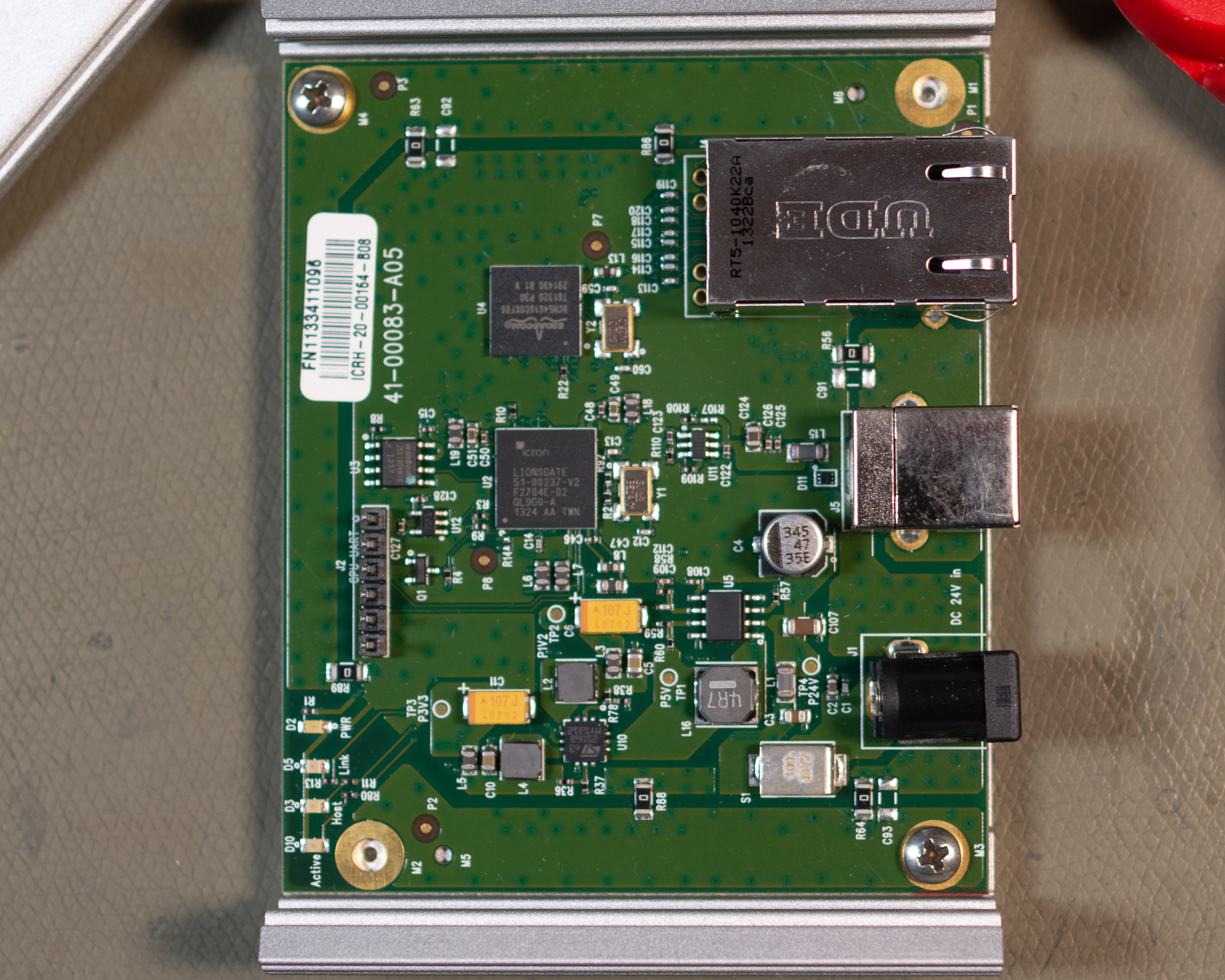Icron USB Ranger 2212 Pictures

I bought a used Icron USB Ranger 2212, and took a look at how they implemented the Cat5 extender.
The USB Ranger 2212 is a 2-port USB extender using Cat5 or better, up to 100 meters. The neat feature of the 2212 vs. e.g. the 2214 or older units, is that the remote end (REX) of the extender is powered from the local end (LEX).
Updated: after using this device for a while, I discovered some issues. It seems that at least with modern keyboards/mice and several hubs following this extender, the USB communications become unreliable. This resulted in dropped key-presses and mouse clicks. Restarting the REX seemed to temporarily improve the situation, but I've moved back to the low cost USB-RJ45 adapters for now. I suspect the newer 23xx devices are more reliable with modern hardware (the 2324 doesn't seem to have these issues).
See also my post about the 2324 fiber-optic extender.
This means you get full power (500 mA per port) at the REX without an extra power supply.
The units are built in the same basic chassis, and like the 2324 they only use two mounting screws for the PCB despite having 4 of them in the chassis (it also looks like the PCB holes are slightly off center).
The chassis doesn't have any external mounting screw holes, so if you want to attach it to something you have to add those yourself or use tape etc.

The LEX contains a basic power supply (the unit runs off an external 24 V supply), it appears to be a 2-stage design with an input buck making 5V, and a secondary controller making 3.3 and 1.2 V.
The main chip is an Icron LionsGate ASIC (Icron also sells these ASICs as OEM parts, but documentation seems to be under NDA).
I didn't reverse engineer the pinout, and couldn't find an exact match for the RJ45 part number, but it appears to be a standard PoE capable magjack type (with built in transformers).
This suggests they're using a standard PoE wiring scheme, but running at 24V, probably similar to other 24V passive PoE systems. There doesn't seem to be any specific regulation or current limiting for the PoE power output at this end. I would strongly advice users to check that their network cables are wired correctly before plugging these devices in, to avoid damaging the LEX or REX.
The LionsGate ASIC seems to have a built in CPU, and a serial flash + UART interface available.
Between the ASIC and the RJ45, there is a BCM5461 1000Base-T Ethernet PHY, suggesting they're using the same basic design as the 2324 and using a 1000 Mbit⁄s Ethernet interface as the transport mechanism. This seems sensible, and plays well with using Cat5 cabling and PoE. In addition, Ethernet PHYs are quite good at dealing with low quality or incorrectly wired network cabling.

The REX has some of the same stuff as the LEX, it uses the same RJ45 jack, Ethernet PHY, and ASIC.
The large transformer is a PoE transformer designed for 5 V output. There is a mystery chip near the input (after the bridge rectifier). This is likely a switching controller, possibly using magnetic feedback from the auxiliary winding of the transformer. The output from the transformer is rectified and seems to be used without further secondary side regulation.
The USB output is connected to a SMSC (now Microchip) USB2514 4-port USB Hub. You might be able to mod the board to get access to 2 extra ports if you really want to.
The IC to the top right seems to be a 500 mA eFuse, implementing the per-port current limit. This device follows the old USB power spec, and will limit current to 500 mA and flag a fault if overloaded.
Conclusion
The Icron 2212 works well for me, and I had no issues using this device with Cat6 SFTP cabling. The design seems to be decent, and the PoE power delivery provides much more reliable power to the devices than the much cheaper active extender cables or similar generic Cat5 extenders.
For short stretches (up to maybe 15 meters), there doesn't seem to be a significant advantage to this system, as long as AWG 23 network cable is used.
The LEX powered system is only available in the 1 and 2 port variants, with 4 port devices requiring a remote power supply. It's unfortunate that they didn't use a more modern high power PoE implementation (using 48+ V power), as this could have provided enough power for 4 ports with LEX power.